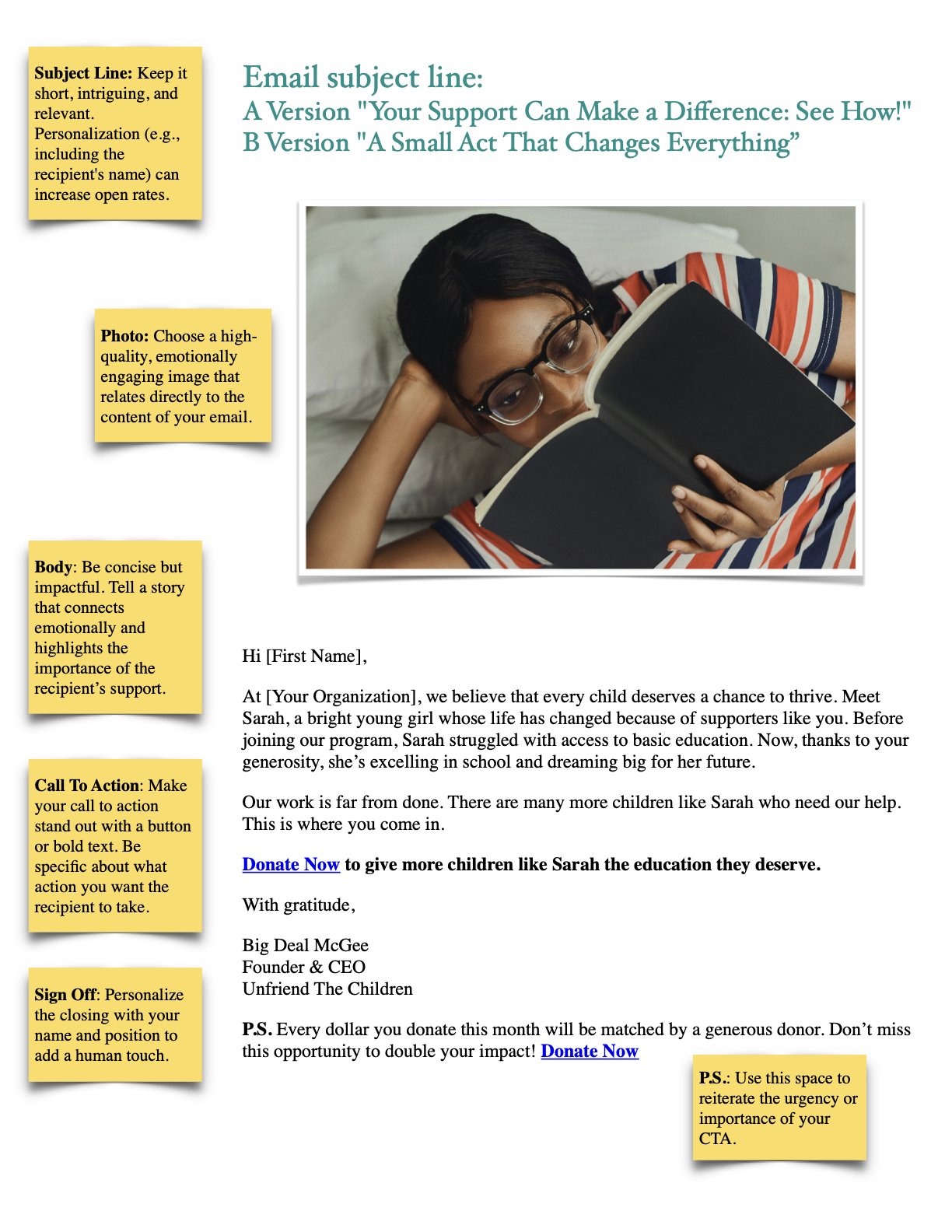Fix Your Fundraising - Email Marketing
"Fix Your Fundraising" is a blog series that empowers nonprofit organizations to enhance their fundraising capabilities through strategic advice and practical solutions. Each post tackles common fundraising challenges, offering insights on donor engagement, digital strategies, and effective communication to maximize impact and achieve fundraising goals.
Email marketing remains one of the most powerful tools for nonprofits or companies to engage with their supporters, drive donations, or sell products. With a strategic approach, you can create compelling email campaigns that resonate with your audience and significantly boost your fundraising efforts. This week, we explore key strategies to master email marketing and enhance your nonprofit's fundraising success.
1. Build a Quality Email List
Your email list is the foundation of your email marketing efforts. Focus on growing a high-quality list of engaged subscribers. Offer valuable content or incentives, such as a free guide or access to exclusive updates, in exchange for email addresses. Ensure that your sign-up forms are easy to find and fill out on your website and social media pages.
2. Craft Compelling Subject Lines
The subject line is the first thing your subscribers see, determining whether they open your email. Craft subject lines that are clear, concise, and intriguing. Use personalization to grab attention, such as including the recipient's name. Don't be afraid to experiment with different styles and analyze open rates to see what works best for your audience. A/B testing is also crucial—most providers will allow you to try two different subject lines with a small trial group, and whichever is the most responsive is used for the remaining group.
3. Personalize Your Content
Personalization is not just about using the recipient's name. It's about building a stronger connection with your audience. Segment your email list based on donor behavior, interests, and engagement levels. Tailor your content to address the specific needs and preferences of each segment. Personalized emails are more likely to resonate with your audience and make them feel valued and understood.
4. Tell Compelling Stories
Storytelling is a powerful way to connect with your donors emotionally. Share stories highlighting your programs' impact and the people who benefit from your work. Use vivid imagery and heartfelt narratives to bring these stories to life. Show donors how their contributions are making a difference. Please don’t use guilt, black-and-white photos, and slow piano music. You’re better than that.
5. Include Clear Calls to Action
Every email should have a clear call to action (CTA) telling your subscribers what they want to do next. Whether donating, signing up for an event, or sharing your content, make sure the CTA is prominent and easy to follow. Use action-oriented language and provide multiple opportunities to click through. There can only be one CTA per email. Don’t load people up with a buffet choice of action. It’s more likely to confuse and frustrate than help.
6. Optimize for Mobile Devices
With many emails opened on mobile devices, ensuring your emails are mobile-friendly is crucial. Use a responsive design that adjusts to different screen sizes. Keep your content concise and use larger fonts and buttons to enhance readability and usability on mobile devices. We need to think about MOBILE FIRST, then desktop. If your email looks terrible on a phone, don’t send it. Fix it.
7. Measure and Track
Analyze key metrics such as open rates, click-through rates, and conversion rates to refine your strategy and improve future campaigns. Ensure you use these as part of your monthly Key Performance Indicators (KPIs).
8. Crucial Pieces of a Quality Email
[Email Subject]: "Your Support Can Make a Difference: See How!"
![Photo of a happy child holding a book]
Hi [First Name],
At [Your Organization], we believe every child deserves a chance to thrive. Meet Sarah, a bright young girl whose life has changed because of supporters like you. Before joining our program, Sarah struggled with access to basic education. Now, thanks to your generosity, she’s excelling in school and dreaming big for her future.
Our work is far from done. There are many more children like Sarah who need our help. This is where you come in.
Donate Now to give more children like Sarah the education they deserve.
With gratitude,
Big Deal McGee
Founder & CEO
Unfriend the Children
P.S. Every dollar you donate this month will be matched by a generous donor. Don’t miss this opportunity to double your impact! Donate Now
Tips for Each Element:
Email Subject: Keep it short, intriguing, and relevant. Personalization (e.g., including the recipient's name) can increase open rates.
Photo: Choose a high-quality, emotionally engaging image that relates directly to the content of your email.
Body: Be concise but impactful. Tell a story that connects emotionally and highlights the importance of the recipient’s support.
CTA: Make your call to action stand out with a button or bold text. Be specific about what action you want the recipient to take.
Sign Off: Personalize the closing with your name and position to add a human touch.
P.S.: Use this space to reiterate the urgency or importance of your CTA.
This structure ensures that your email is engaging and clear and drives the desired action from your readers.
Mastering email marketing can significantly enhance your nonprofit's ability to engage supporters and drive donations. By building a quality email list, crafting compelling subject lines, personalizing content, telling impactful stories, including clear CTAs, optimizing for mobile, and continuously testing and analyzing your efforts, you can create powerful email campaigns that resonate with your audience and boost your fundraising success.

